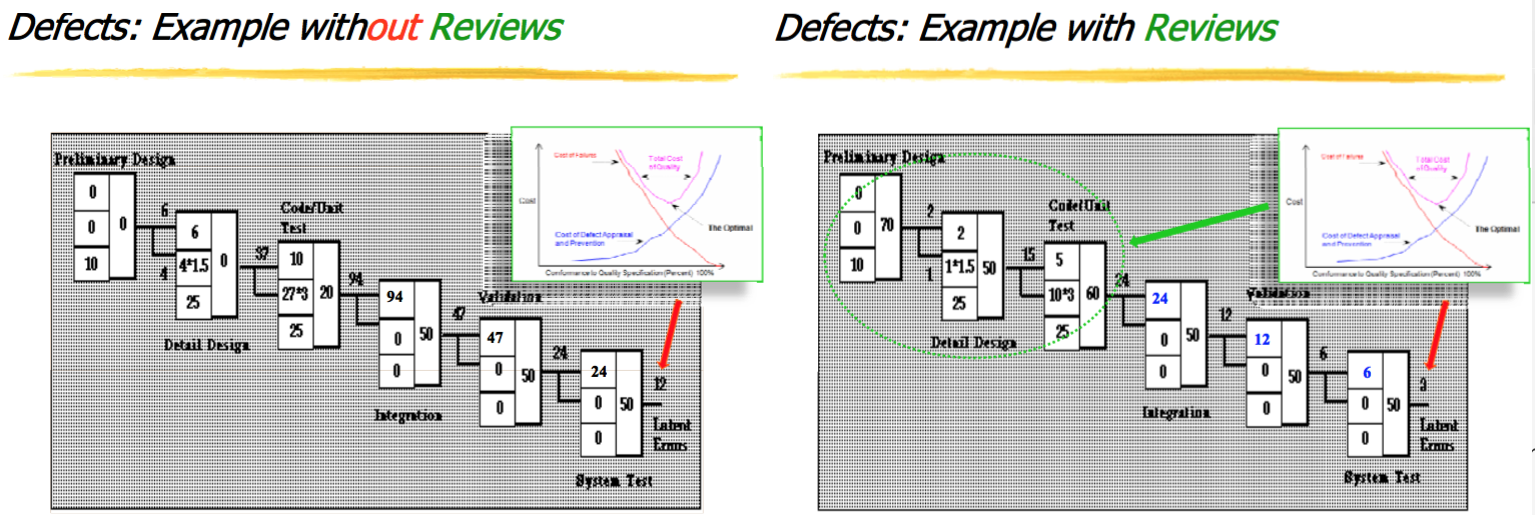Software Reviews & Inspections
Types identified by IEEE Standard:
Management Reviews
Peer Reviews
- Walkthroughs
Inspections
Technical Reviews
Audits
Technical reviews
Confirms that product
- Conforms to specifications
Adheres to regulations, standards, guidelines, plans
Changes
properly implemented
affect only those system areas identified by the change specification
Software artifacts subject to technical reviews
SRS: Software requirements specification
SDS: Software design description
STD: Software test documentation
Software user documentation
Installation procedure
Release notes
- Outputs = documented evidence that identifies:
- project under review
- review team members
- software product reviewed
- inputs to the review
- review objectives and status
- list of resolves\/unresolved defects
- lift of management issues
- action item status
- recommendations for unresolved issues
- if software product mets specification
Technical review meeting
Roles for the technical review
Decision maker
Review leader
Recorder
Technical staff
3-5people (reviewers)
including: producer, review leader, reviewers
<2 hr advance prep + >2 hr meetings
for a small part of the overall software
must have a follow-up procedure
- ensures any corrections are completed
At end of review, attendees decide based on“criteria” to:
accept the work product w\/o modification
reject the work product
- corrected then another review performed
* **accept **the work product **provisionally**
* minor errors to be corrected, no further review
- Conducting Review
- prep: evaluate product prior to review
- revier prodict ARTIFACT not producer
- milk tone: question, don't accuse
- stick to review agenda
- raise issues, don't resolve issues
- avoid style discussions, stick to technical correctness
- schedule reviews as project tasks
- record\/report review results
Auditing
independent reviews that assess compliance with specs, standards, and procedures'
done before software release
Physical Audit: check that all items identified as part of configuration are present
Functional audit: check that unit, integration and acceptance tests have been carried out and that recorrds show their success or failure
Traceability
Forward: each input to a phase must be matched to an output of the same phase to show completeness
Backward: each output is traceable to an input of a phase
Software Quality Standards
Standards: an approved, documented, and available set of criteria to determine adequacy of an action (process standard) or object (product standard).’
Guidelines: well-defined\/documented set of criteria that guides an activity or task.’ (Dorfman & Thayer, 1990) - allows for judgement and flexibility
Categories of Standards and Assessment
Product Standards
Process Standards
Calibration and Measurement Standards
Quality Management Systems Standards

Testing Activities
Test Condition: description of circumstances that could be examined (event\/item). Categories: functionality, performance, stress, robustness. Derive using testing techniques i.e. V-model
TestCase\/Data: a pair (test data(value\/input per var), expected output). Execution of a testcase against program P covers certain: req's of P, parts of P's functionality, parts of P's internal logic
Test Set: Collection of >0 test cases. i.e. function test case for sort:
- test data = <12 -29 32>, expected output = -29, 12, 32, actual output = ???, evironment pre req's = file, net connection....
Build Test Case (implement)
Implement the preconditions (set up environment)
Prepare test scripts (may use test automation tools)

Program Behavior
specified by: plain natural language, state diagram, formal mathematical specifcatin, etc.
- state diagram specifies program states & how program changes state on input
Observation\/ Analysis: can be complex for large programs
- observe behavior
analyze observed behavior (correct or not?)
Oracle: system that checks correctness of observed behavior
- Oracle Programs(complex): automated oracles that require determination of input-output relationship. i.e. matrix multiplication program used to check if matrix inversion program produced correct output.
Scripts Test Case
Scripts contain data\/instructions for testing:
comparison info
what screen data to capture
- when\/where to read input
control information
- repeat set of inputs
- make a devision based on output
testing concurrent activities
Comparison
compare (test outcomes, expected outcomes)
simple\/complex. Types:
- variable values (in memory)
- disk based (textual, non-textual, database, binary,...)
- screen based (char, GUI, images)
- Others (multimedia, communicating apps0
actual output =? expected output
- yes = pass (assuming testcase was "instrumented")
- no = fail (assuming no essor in test case, preconditions)
Dynamic Tests
